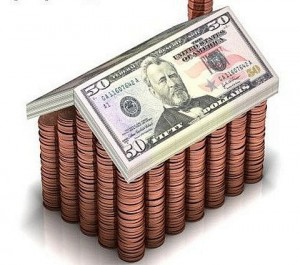It’s one of the most common complaints among Realtors, builders and analysts – tight lending from private banks has not only restricted potential homebuyer’s access to credit, but has been one of the leading contributors to the housing downturn since 2007 and the prime reason for housing’s sluggish, sideways growth the last two years.
We’ve addressed the validity of those claims on a couple of occasions recently, but in summary – when one analyzes the statistics of lending, today’s lending environment only seems severe when compared to the conditions of the boom-era, where just about anyone received a loan. Our analysis, however, dealt more with credit scores and LTV ratios, and a new article by Diana Olick of CNBC offers further perspective on lending while analyzing average down payments.
The common talking point, Olick writes, is that a minimum of 20 percent down is needed in order to secure a prime home loan. Yet, a new report from LendingTree that analyzes the average mortgage payments state-by-state offers a very different take.
The state with the highest average mortgage payment was New Jersey, but even as the top state, its average mortgage payment was only 13.76 percent, while the lowest, North Dakota, was at 12.29 percent.
“Both are well below the 20 percent we all complain about,” Olick writes.
A recent HSH blog by Peter Miller cites similar statistics, except Miller’s stats, ironically, come from the National Association of Realtors (NAR), one of the most vocal critics of the private home loan industry.
According to the NAR, 2011’s median down payment was 11 percent, with first-time buyers averaging at 5 percent and repeat buyers at 15 percent. New-home purchases averaged at 13 percent, and existing-home purchases were financed with a 10 percent down payment.
Most revealing was this quote, which Miller provided from the NAR: “Fifty-four percent of first-time buyers financed with a low down payment FHA mortgage, and 6 percent used the VA loan program which, requires no down payment.”
So, a whopping 60 percent of first-time homebuyers put 3.5 percent or less down on their homes in 2011, and that majority explains where the 12 and 13 percent averages of the LendingTree report derive from.
Guy Cecala, of Inside Mortgage Finance, said in Olick’s piece that between the low-cost options from the FHA and VA and the more demanding offerings from Fannie Mae, Freddie Mac (which require at least 10 percent) and especially jumbo loan offerings (which often require even more than 20 percent), lies the LendingTree median.
“An average of 12 or 14 percent is not impossible, but it doesn’t really mean that a lot of people are actually getting mortgages with those ‘average’ down payments,” Cecala said.
Of course, there are downsides to accepting a loan offer with a lower down payment. With such loans often containing a higher risk, lenders will often require the homeowner to pay costlier mortgage insurance, as is the case at the FHA.
“The reality is when you put less than 20 percent down, you have to pay for some kind of insurance to protect the lender from the higher risk that you’ll default…but private mortgage insurers these days aren’t always willing to do business with low down payments,” a LendingTree spokesman said.
LendingTree was also quick to condemn, though, upcoming legislation from federal regulators that would adopt a mandatory 20 percent down payment for new home loans, a measure designed to make the loans easier to securitize and sell on the marketplace.
“If Federal regulators were to adopt the proposed 20 percent down payment requirement, a majority of borrowers wouldn’t be able to meet the standard given the findings in this report,” said Doug Lebda, founder and CEO of LendingTree.
